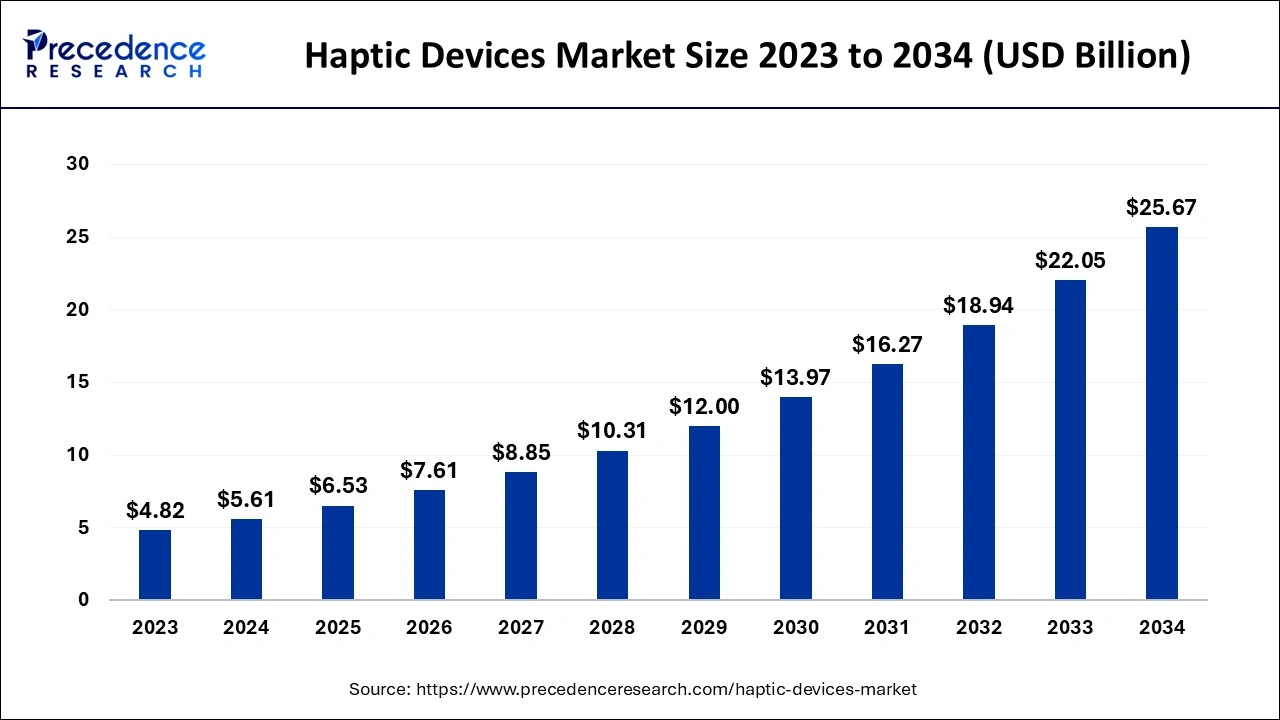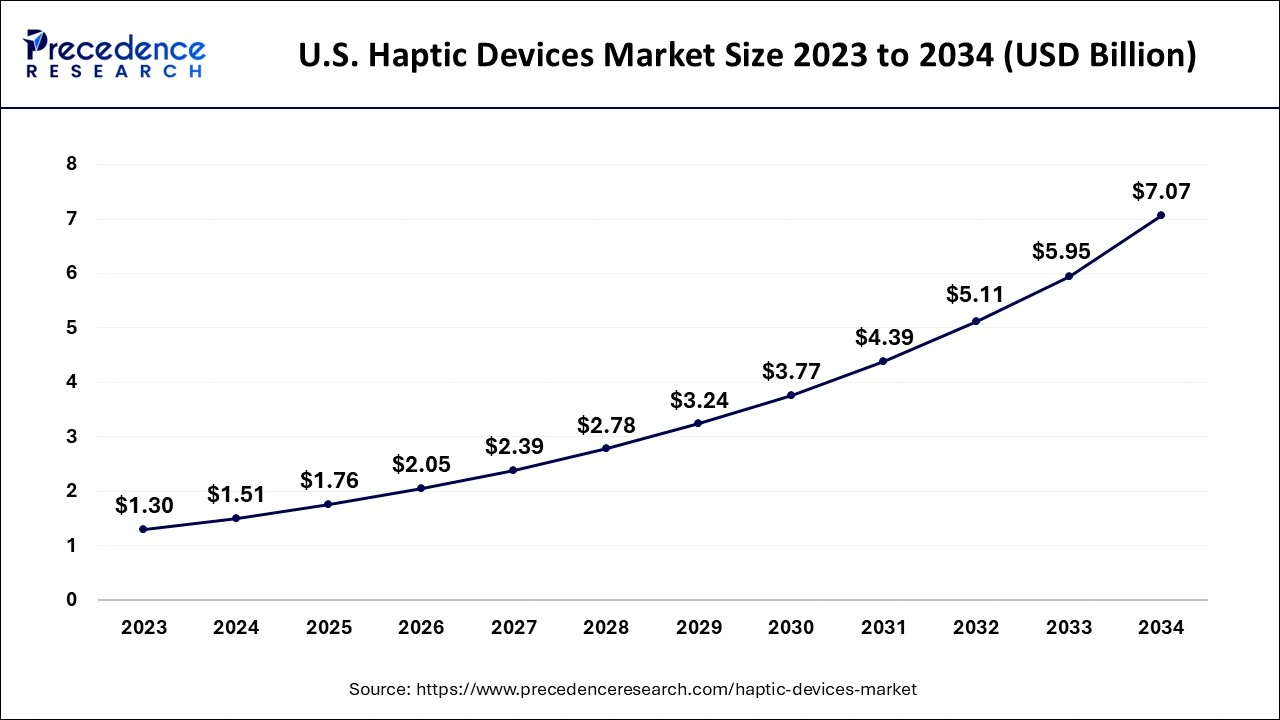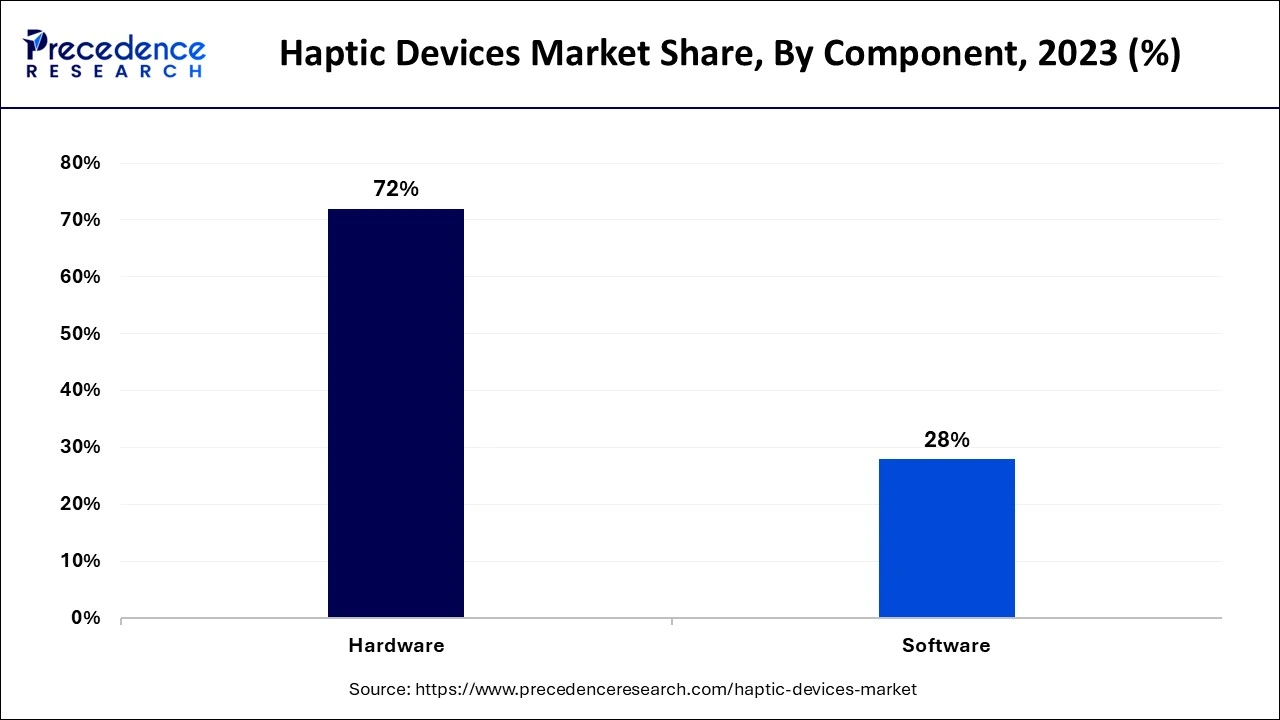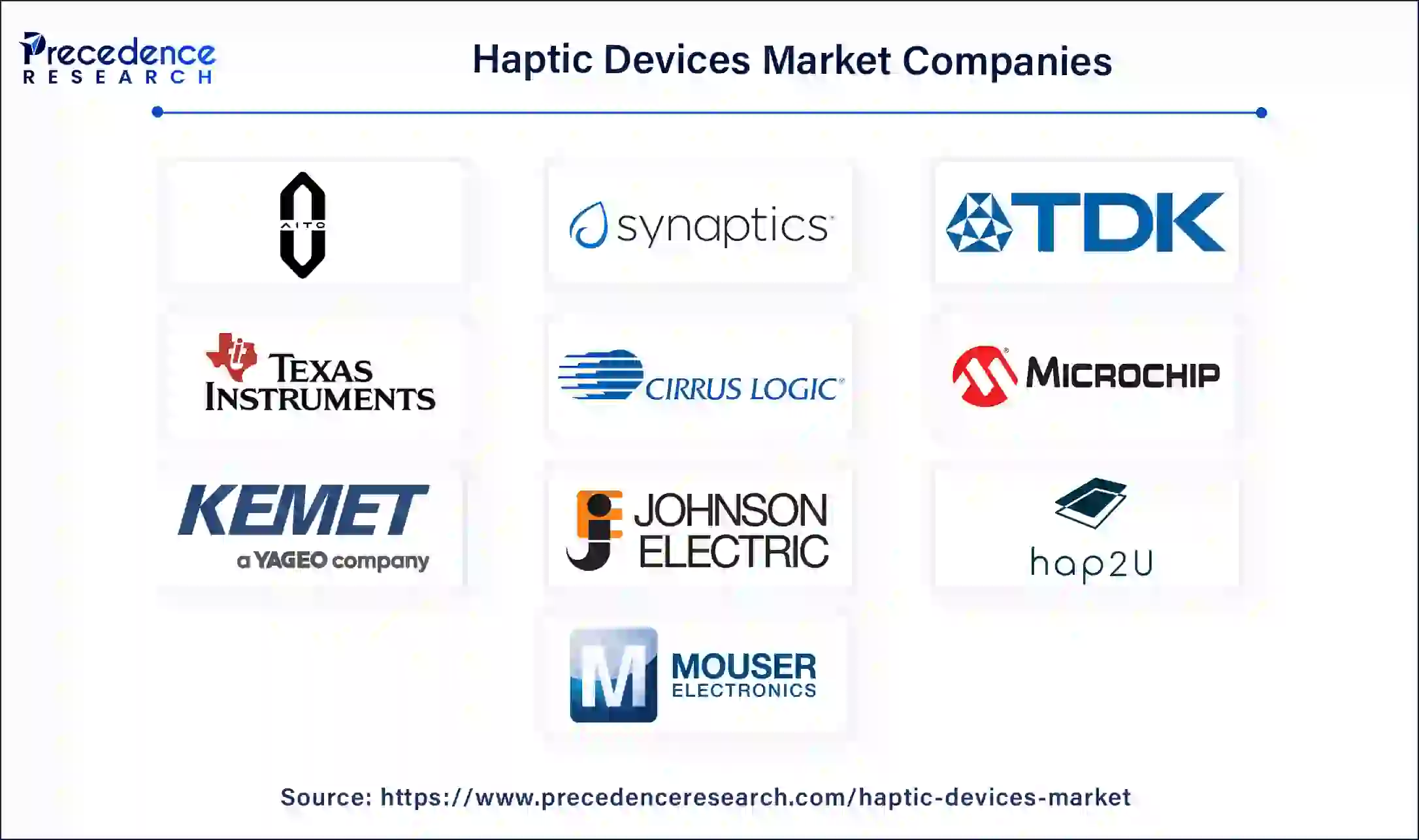December 2024
The global haptic devices market size accounted for USD 5.61 billion in 2024, grew to USD 6.53 billion in 2025 and is expected to be worth around USD 25.67 billion by 2034, registering a CAGR of 16.42% between 2024 and 2034. The North America haptic devices market size is calculated at USD 2.02 billion in 2024 and is expected to grow at a CAGR of 16.53% during the forecast year.
The global haptic devices market size is calculated at USD 5.61 billion in 2024 and is projected to surpass around USD 25.67 billion by 2034, expanding at a CAGR of 16.42% from 2024 to 2034. The haptic devices market is experiencing significant demand due to the increasing growth in virtual reality (VR) and augmented reality (AR). These devices are gaining constant popularity in the entertainment and gaming industry.

The U.S. haptic devices market size is evaluated at USD 1.51 billion in 2024 and is projected to be worth around USD 7.07 billion by 2034, growing at a CAGR of 16.64% from 2024 to 2034.

North America dominated the global haptic devices market in 2023. The dominance of the region is attributed to the presence of countries like the United States which focus on technological advancements in their healthcare sector. Additionally, the well-established gaming industry in the U.S. and Canada is leading to the increasing demand for VR and AR. This demand is attracting multiple investments that focus on enhancing the user experience in various applications.

Asia Pacific is anticipated to register the fastest growth in the haptic devices market during the forecast period of 2024 to 2034. The growth of the region is attributed to the rapid urbanization which leads to the rising usage of consumer electronics. Countries like China, India, and Japan are also countries that are investing heavily in their healthcare technologies. Additionally, the rising health and fitness trend in the region is anticipated to bring many opportunities in wearable technologies.
Haptic devices refer to human-machine interfaces that stimulate the sense of touch through the application of force, vibrations, or motions. These devices use motors, sensors, and speakers to create haptic feedback, which can help people feel the experience of a physical touch. The haptic devices market is growing significantly due to the enhancement of the sense of presence, which boosts the user experience. These devices are used in various applications like gaming, healthcare, robotics, and many more. Many more technological advancements in wearables and other domains have become common in recent years.
How Can AI Contribute to the Haptic Devices Market?
The rise of artificial intelligence (AI) and machine learning (ML) has had an impact on the growth of the haptic devices market. These technologies can analyze real-time movements, which can help them adapt to necessary changes. The adoption of technologies is being widely used to improve gesture recognition in haptic devices that can understand various actions and intentions of the individual. The capability of AI algorithms to analyze huge datasets is also helping towards the growth in improving various functionalities in the gaming and entertainment industry.
| Report Coverage | Details |
| Market Size by 2034 | USD 25.67 Billion |
| Market Size in 2024 | USD 5.61 Billion |
| Market Size in 2025 | USD 6.53 Billion |
| Market Growth Rate from 2024 to 2034 | CAGR of 16.42% |
| Largest Market | North America |
| Base Year | 2023 |
| Forecast Period | 2024 to 2034 |
| Segments Covered | Component, Usage Outlook, Type, Feedback, End-user, and Regions |
| Regions Covered | North America, Europe, Asia-Pacific, Latin America and Middle East, & Africa |
Immersive demand for VR and AR
Technological adoptions have led to rising quality standards in virtual reality, where people can experience an immersive environment. The adoption of augmented reality and virtual reality is rising in the gaming industry, which leads to the need for real-world experience, allowing users to feel virtual objects. The haptic devices market is experiencing significant demand due to the rising demand for handheld controllers, vests, and gloves, which help enhance the user experience. Additionally, the increasing use of VR and AR in defense and aerospace applications is becoming common.
Adoption in healthcare applications
The increasing technological adoptions in the healthcare sector are significantly contributing towards enhanced outcomes. The haptic devices market plays a crucial role as the technology is used in medical education, helping students understand the human body and patients thoroughly. These devices have proved themselves in delicate surgeries, where they have helped the professionals feel the resistance of tissues, which has helped during the whole procedure. Additionally, the growth in remote surgery is expected to drive market growth, which will help professionals operate patients from remote locations through robotic systems.
Higher costs
Haptic devices use advanced technologies, which often have higher manufacturing costs due to the use of advanced materials, making them unaffordable for small-sized companies in various industries. Sensors and actuators are the main components of the devices there. They create the sensations, helping the user experience an enhanced real-time environment. Additionally, the use of these devices in the aerospace and defense sector requires high maintenance, which can be unaffordable for some players.
Growing popularity in the automotive sector
The rapid advancements in vehicles, especially four-wheelers, boost the demand for haptic devices, which are being replaced by gesture-based systems. This is leading to more demand in the haptic devices market, where they are being used to enhance the user experience through personalized solutions. Advancements in feedback technologies are also helping to enhance the safety of vehicles, especially autonomous vehicles. Sensors in the vehicle give the driver a signal that can detect any potential threat.
Technological adoptions in the education sector
The educational sector in developed and developing economies is adopting advanced technologies that can help students learn multiple things effectively. The haptic devices market is witnessing significant growth due to the adoption in science, where students can feel the organs and molecules virtually, giving them a better image of the real human body system. Additionally, the rising adoption of various courses is observed.
The hardware segment stood the dominant in the haptic devices market in 2023. Hardware components of haptic devices include sensors and actuators, which are an essential part of the devices. The market is growing efficiently due to the rising investments in the hardware sector, where the industry is witnessing massive manufacturing of these devices. Additionally, the rising use of haptic devices in multiple applications like healthcare, gaming, defense, and aerospace is boosting the demand for production.

The software segment is expected to grow significantly in the haptic devices market during the forecast period of 2024 to 2034. The application of haptic feedback is becoming a crucial part of enhancing the user experience. The market is growing significantly due to the contribution of software in translating physical interactions into feedback. Additionally, the rising use of VR and AR is anticipated to expand the demand for software solutions in the upcoming years.
The touchable segment contributed to the largest share of the haptic devices market in 2023. These devices are widely used in various applications where they provide feedback through physical interaction. The market is growing efficiently due to the rising adoption of consumer electronics like smartphones and tablets. For instance, these devices give a feeling of vibration while using them, which enhances the user experience and helps attract more consumers.
The wearable segment is expected to grow at the fastest rate in the haptic devices market during the forecast period of 2024 to 2034. The growth of the market is attributed to the rising health and fitness trends which has led to the increasing use of smartwatches and bands. The growth of the gaming industry is also leading to multiple advancements in devices like gloves which provide feedback to the users in VR and AR.
The active haptic devices segment led the global haptic devices market in 2023. These devices provide feedback by using actuators and other motors, which provide a sense of vibration and force. The market is gaining significant popularity due to its rising use in gaming, which helps enhance feedback. The rising demand is also leading to technological advancements.
The passive haptic devices segment is expected to grow at a significant CAGR in the haptic devices market during the forecast period of 2024 to 2034. These devices rely on the user’s sensation while using the device. The market is gaining significant popularity due to the rising use of these devices in the healthcare sector which is leading to massive production demand. The massive demand for these devices is anticipated to reduce the device cost due to increasing application in the education sector.
The force segment stood dominant in the global haptic devices market in 2023. The dominance of the segment is attributed to the rising demand for enhanced feedback in gaming stimulation devices, which enhance the sensation experience. The rising demand for force feedback in consumer electronics is leading to multiple opportunities for new market players in gaming and training simulation applications.
The electrotactile feedback segment is expected to grow at the fastest rate in the haptic devices market during the forecast period of 2024 to 2034. The growth of the market is boosted by the application of this technology in wearable devices, which is experiencing rapid demand. Many companies are investing in innovating these technologies in the healthcare sector.
The consumer electronics segment stood the dominant in the haptic devices market in 2023. The market is witnessing rapid growth due to digitalization and rising internet penetration. Haptic feedback is becoming an essential part of these devices, and it requires vibrations and touch interactions while using them. Advancements are being made to help maintain consumer demand.
The healthcare segment is anticipated to grow at the fastest rate in the haptic devices market from 2024 to 2034. The healthcare sector is one of the fastest growing, and they are witnessing the rapid adoption of haptic devices in professional training for surgical use. Many countries are focusing on adopting technologies that will help improve the medical outcomes for their individuals.

Segments Covered in the Report
By Component
By Usage Outlook
By Type
By Feedback
By End-user
By Geography
For inquiries regarding discounts, bulk purchases, or customization requests, please contact us at sales@precedenceresearch.com
No cookie-cutter, only authentic analysis – take the 1st step to become a Precedence Research client
December 2024
November 2024
February 2025
April 2025